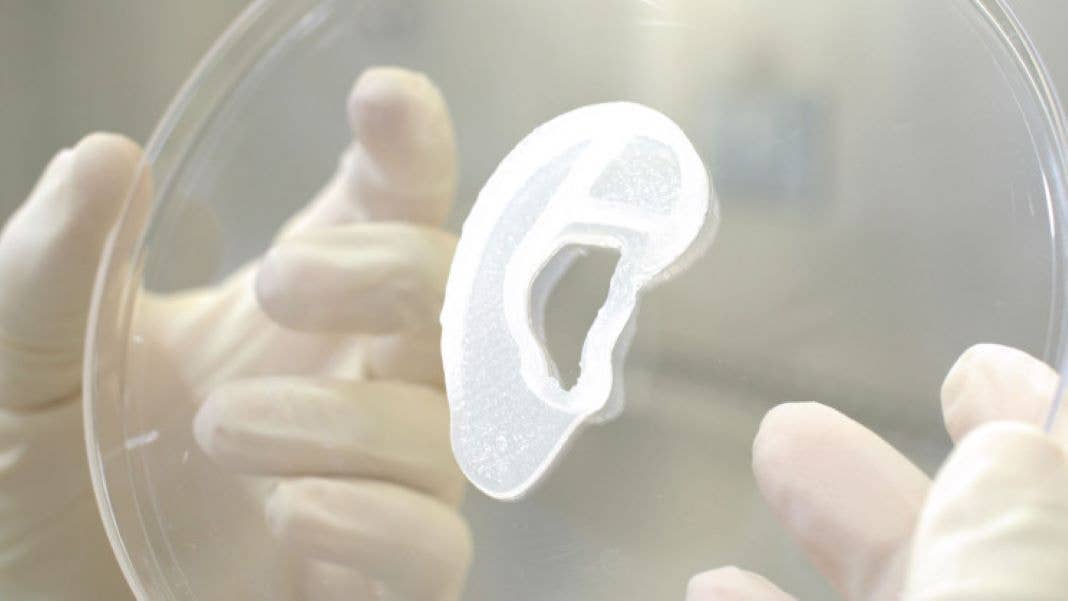In a First, Doctors Transplant a 3D Printed Ear Made of a Patient’s Own Cells

Share
3D printing is becoming commonplace as a tool for manufacturing, construction, and even food preparation, but the technology’s advancement in the medical field has understandably been a bit slower. This week marked a new milestone as the first-ever 3D printed human ear was successfully transplanted onto a patient’s body.
The announcement came from 3DBio Therapeutics, a regenerative medicine company based in New York. The company was founded in 2014 and creates living implants that are custom engineered for patients. There are similar companies, like EpiBone, making customized body parts using a patient’s own stem cells, but 3DBio’s work is focused around tissue and cartilage. That means they could create external body parts, like ears or noses, but also material for the spine and joints.
Needing a new ear isn’t a very common medical issue, but a congenital disorder called microtia causes one or both of a person’s outer ears to be tiny and underdeveloped, or absent altogether (that’s called anotia). The condition affects around 1,500 babies born in the US annually, according to the press release.
Having microtia doesn’t necessarily mean a person is deaf, as the inner ear is often unaffected by the condition; it’s primarily an aesthetic issue, and children with the condition often have surgery to reconstruct the ear when they’re between 4 and 10 years old—but this can be a costly and invasive procedure, using rib cartilage grafts and synthetic materials, and the end result may not be symmetrical to the unaffected ear.
The patient who received the 3D printed ear hadn’t had reconstructive surgery as a child, and she told the New York Times that her ear’s appearance didn’t bother her much until she was a teenager. She’s now 20 years old, and the first transplant patient in a clinical trial that has enrolled 11 other people. Her transplant was completed in March, and over two months later the ear appears to be seamlessly integrating into her body.
Be Part of the Future
Sign up to receive top stories about groundbreaking technologies and visionary thinkers from SingularityHub.


Doctors took a 3D scan of her unaffected ear so that the 3D printed ear would match it in shape and size. They used a collagen hydrogel scaffold seeded with her ear cartilage cells. The press release is light on specific details, as the technology is proprietary, but it’s likely that the “printing” methodology used was similar to one described in a 2016 paper in Nature Biotechnology. There, an integrated tissue-organ printer interwove a cell-friendly hydrogel with a stiffer substance for structural support, leaving tiny channels for oxygen to enter so that the living cells in the center of the structure don’t die.
Similarly, 3DBio says its platform includes a therapeutic-grade bio-ink, processes that rapidly expand the quantity of living cells, and a technology that provides temporary structural support until the ear’s living cartilage grows strong enough to support itself. The company said the implanted ear will continue to regenerate cartilage tissue over time, giving it the look and feel of a natural ear.
"I think my self-esteem will go up," the patient said. Meanwhile for 3DBio, the successful ear transplant is just the beginning. "We believe that the microtia clinical trial can...demonstrate the potential for the technology to provide living tissue implants in other therapeutic areas in the future," said Daniel Cohen, 3DBio’s cofounder and CEO. "We look forward to leveraging our platform to solve other high impact, unmet medical needs like lumpectomy reconstruction and eventually expand to organs."
Image Credit: 3DBio Therapeutics
Vanessa has been writing about science and technology for eight years and was senior editor at SingularityHub. She's interested in biotechnology and genetic engineering, the nitty-gritty of the renewable energy transition, the roles technology and science play in geopolitics and international development, and countless other topics.
Related Articles

New Gene Drive Stops the Spread of Malaria—Without Killing Any Mosquitoes

New Immune Treatment May Suppress HIV—No Daily Pills Required

Scientists Just Developed a Lasting Vaccine to Prevent Deadly Allergic Reactions
What we’re reading